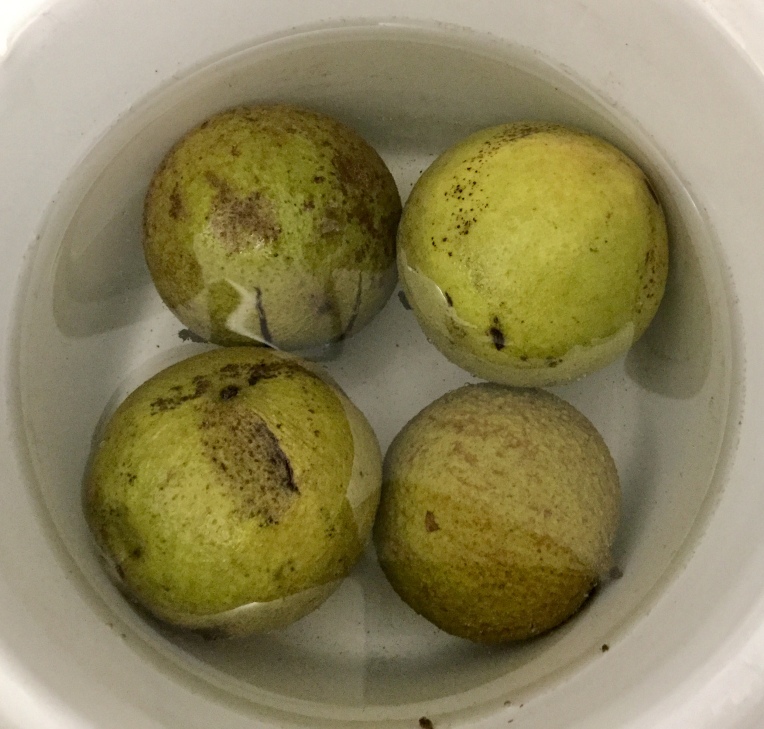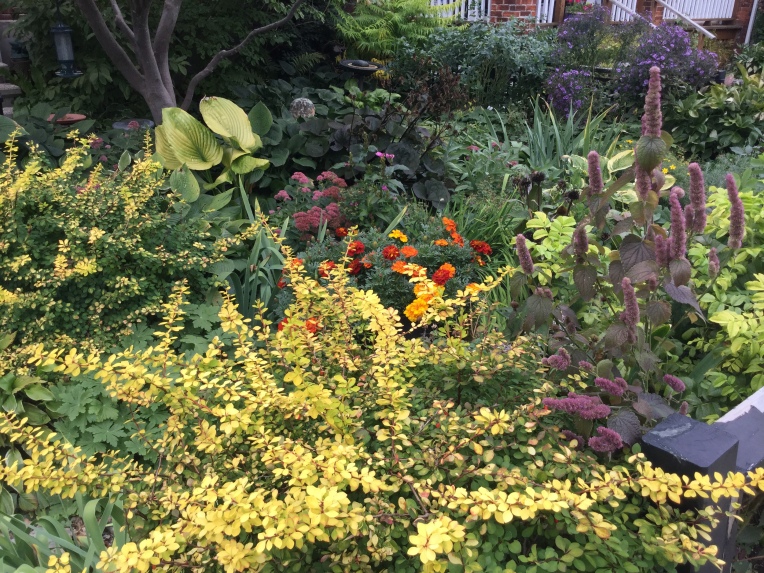
“Inspired by the broken colours and forms of the still-radiant ancient frescos on the walls of churches and streets in Assisi and neighbouring medieval hill-towns, I created a series of Artist Books and textile frescos whose content refers to the natural environment of the Subasio as well as to its powerful spiritual and Dantean heritage. My intention was to research the bioregional plants of the Subasio near the Arte Studionestrelle at Santa Maria di Lignano and to discover natural pigments which I could use to dye and print locally-made paper and vintage linen. I was interested in a contemporary application of the traditional knowledge about natural dyes associated historically with this region of Italy where much of that older wisdom seems to have disappeared. My question was: Could some version of that knowledge be restored? The October native vegetation growing high up the mountain provided a rich palette from leaves, bark, berries and late blooms that worked together in successive layers of dye and print. My work on this beautiful mountain recalls to me the Fioretti (Little Flowers) of Saint Francis of Assisi whose love for the Umbrian landscape brought him and others closer to God. And although I was here too late in the season to use the traditional ginestrelle blooms in my prints, I was able to obtain much colour from their seed pods! ” (Shlomo Feldberg constructed covers and boxes for Wendy's Artist Books during his residency in addition to completing his own mixed media work.)
The statement above about my work during my residency at Arte Studio Ginestrelle appears in the catalogue for the show of contemporary art at the public art gallery of Assisi. The show takes place the last week of November. As well as the inspiration I found so abundantly in and around Mount Subasio, I am pleased to share with you some of the Artist Books and textiles created during my October 2013 residency and featured in the annual exhibit by many of the Artists In Residence. I have also brought home with me many eco printed papers and textiles that will form much of my work later in the winter.
First pic: Umbrian handwoven linen, highly textured and serviceable cloth; an Assisi-fleamarket find, vintage but never used.
It took me many prep and printing sessions with mordants and local plants to express the Giotto/Cimabue/Pintoricchio fresco colours I had in mind. Even then, I used madder dye powder for the reds since Rubia tinctorum does not grow at almost 1000 metres above sea level where the Studio is located.
The abundance of yellows in the earlyOctober leaves was a challenge. During my first week of printings, shades of yellow or brown was all I could manage to obtain using a basic alum acetate mordant. Hmm. I knew I would print the papers and cloth several times again for more colour and form.
As the October days passed, the fall colours began to change and pigments both increased and decreased in the leaves. I searched for sources of blue and found them in Dogwood berries (Cornus sanguinea), Sloes (Prunus espinosa – tiny plums) and Cotinus coggygria (more blue after the middle of October). Purple showed in the bark of walnut twigs (Juglans regia) as well as late blackberries (Rubus fruticosus) and sloes; greens from Dogwood leaves (and berries, too); moss greens from Rosa canina (Dog Rose). The yellows were varied: Golden-apricot from Olive leaves; deep golden from Walnut; yellow-chartreuse from Sumac. The “ginestrelle” or Dyer's Broom (Cytisus scoparius in these parts) had only seed pods for printing tannin browns in October, its brilliant yellow blooms long gone.
Here, blue, green and teal from Dogwood berries and leaves:
And the enticing golden yellows from European Walnut on old cotton sheets:
A small display of yellows with iron (flowers by Shlomo)
Dogwood greens, walnut yellows and deep browns; pinks and purple-pink from walnut twig bark.
Rusted silk chiffon with BlackBerry and Dogwood berries:
Dogwood and walnut with the last sunflower:
Walnut with Dogwood, Elder and iron:
Artist Books : “Subasio Scrolls”
With the Subasio Scroll Collection I am continuing to develop an earlier goal: to use the accordion book form as a botanical scroll. This collection of three books is entilted “Little Plants of the Subasio: October Scroll” (1, 2, 3). A fourth book is coptic-bound and contains my handwritten copies of sayings from Dante and Francis of Assisi. The book is also entitled “Little Plants of the Subasio”.
Each page of each book, back and front, is printed with leaves, bark and/or berries and fruits of the area around Arte Studio Ginestrelle, which is llocated nearly at the top of this part of the Subasio. The range of available plants changes with the altitude (here, between 800 and 1000m.) So while madder might be found on the bottom layer of the vegetation belt, only a relative (Galium lucidum, but not a red one! ) was found at the mid-to-high level where the Studio is.
My aim was to use only what I could forage within that vegetation layer on the mountain and therefore not to import plants from other areas. I did succeed in that aim, except for my use of powdered madder…one cannot express the spirit of Giotto's frescos without red! All the other plant colours came from the vegetation right at hand.
(Aside: I was unable to find any really good locally-made paper for my books , despite the fact that the Fabriano art paper factory is within a few hours drive of Assisi and the other hill towns. The art supply shop in Florence was closed on Saturdays, the day we went there. One bookbinder we met in Florence says he sends for his supplies to Talas in Brooklyn!!! Or to Paris or Germany. Wow. )
Some of my main pigment sources were: Juglans regia, Cornus sanguinea, Rubus fruticosus, Prunus espinosa, Robinia pseudoacacia (invasive, introduced), Carpino nero, Quercus robur, “Rutacae” – species unknown except for the family relationship), Sambucus negra, Rosa canina, Acer opalus, plus Olive and Grape.
My “Subasio October Scrolls” collection of Artist Books consists so far of three accordion-spined and one coptic-bound book. ( Covers and Book Box were made by Shlomo Feldberg using my printed textiles and papers.) These Artist Books remain in Assisi for exhibition. Others will be added to the collection in time as I continue to work with the many papers and textiles I made there and brought home.
Below: Walnut leaf print on the box: walnut dyed linen thread for the book stitiching
Completed scrolls atop the reference books I used to help me identify the native and local plants. I had hope they could tell me which might be for use as sources of pigment. None of these books discussed the traditional dye uses of the plants, even when they gave extensive info about medicinal use. This confirmed my supposition that natural dye knowledge about the area was limited or non-existent.
A wild fennel and rust page in one of my books:
Walnut leaf page:
An arrray of pages in a scroll book:
The spine of a book with plant labels in English, Latin and Italian:
Robinia pseudoacacia:
Carpino nero (Black Hornbeam):
The little coptic-bound book of sayings from Dante and Francis of Assisi; on ecoprinted pages:
Dante, Canto IX. Mount Subasio and some prayer-poems by Francis of Assisi.
Title page:
Book box and book covers:
I leave you today with a promise to post more pics and info when (a) I have sorted and retrieved some lost photos (FB crashed iPhoto and ate my camera upload…lost a LOT of pics!!!) and (b) after we have moved to our new house next week.
(This is not our new house)
Those colours! The ducal palace at Gubbio, the town where Francis tamed the wolf:
Here is more inspiration from tne colours and forms of Umbria:
The view from our bedroom:
Look up for inspiration:
Look down…
Even the distressed surfaces inspire: in fact, these above all…
I hope I leave you looking for more like Brother Cat Cimabue (L) and Brother Cat Negrito (R)- the Studio's Resident Royalty, assigned to outdoor duties but skilled in finding “work” inside
More pics next time! Leaf prints for book pages, inspiration photos…and photos of the Studio and environs.
Best to you, dear Reader.





















 First task was to extract the colour from the berries. Now I have to admit that at this point, I did not follow the instructions in Jason’s book. His practice is to just squash the fresh berries and use the juice uncooked. I decided to go with traditional dye extraction practice for this first attempt; this involved crushing the berries, covering them with water, cooking them at a simmer in the slow cooker until the water took on a dark purple-blue colour and then straining them in a jellymaking bag:
First task was to extract the colour from the berries. Now I have to admit that at this point, I did not follow the instructions in Jason’s book. His practice is to just squash the fresh berries and use the juice uncooked. I decided to go with traditional dye extraction practice for this first attempt; this involved crushing the berries, covering them with water, cooking them at a simmer in the slow cooker until the water took on a dark purple-blue colour and then straining them in a jellymaking bag:





 With the addition of other modifiers besides alum, other colours besides greens developed. Ammonia gave brownish-yellow, soda ash gave yellows, lemon juice and white vinegar gave pink, without alum. Here are some of the samples:
With the addition of other modifiers besides alum, other colours besides greens developed. Ammonia gave brownish-yellow, soda ash gave yellows, lemon juice and white vinegar gave pink, without alum. Here are some of the samples:














 The fall garden
The fall garden 


















































































